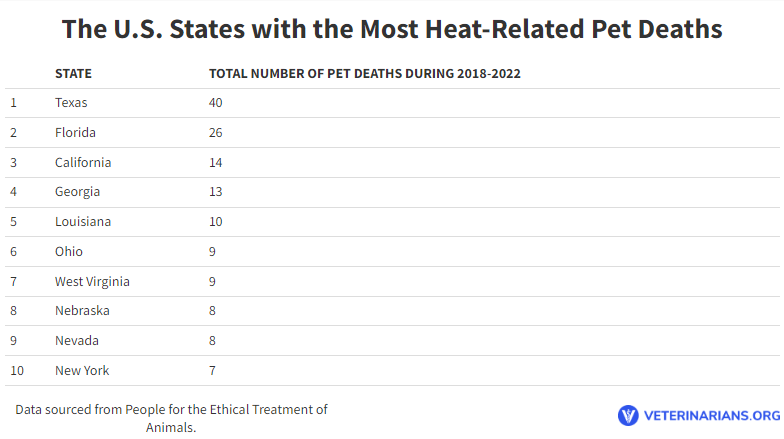The U.S. States with the Most Heat-Related Pet Deaths

Table of Contents
Every year, local authorities receive reports of heat-related pet deaths as early as April, most of which are the result of a pet being confined in a hot vehicle.
The Special Reports Team at Onevet.ai analyzed five years of news report data from 2018-2022 to determine which states saw the highest number of reported heat-related pet deaths during this time period.
While the majority of heat-related pet deaths studied were the result of an animal being confined inside a hot vehicle, the analyzed reports also include incidents of heat-related death due to confinement in trailers, garages, or sheds, as well as heat-related deaths due to animals being left outside in extreme heat with no shade or water.
The results are listed below:

Overall, nationwide, over 250 animals died due to heat-related causes during 2018-2022, with most deaths being the result of confinement in a hot vehicle. This number only represents the number of incidents that were reported to local authorities, however, and is likely significantly higher.
The top 10 states in the above ranking make up more than half (57%) of the total number of reported heat-related pet deaths in the entire nation.
Texas tops the list with 40 reported heat-related pet deaths during the analyzed period. This number is more than 6 times the national five-year average. In 2021 and 2022 alone, Texas saw its highest numbers of heat-related pet deaths during the studied five-year period.
Florida follows up in second with 26 reported heat-related pet deaths during the analyzed period, a number that’s more than 4 times the national five-year average. In the year 2022, Florida saw its highest number of reported heat-related pet deaths during the studied five-year period.
Across all states, dogs are the most common pet cited in the analyzed reports, making up 97% of heat-related pet deaths.
Heat-related reports over the five-year period were made as early as April each year.
Heat-Related Rescues
In some cases, authorities and/or bystanders were able to successfully rescue animals at risk of a heat-related death.
In 2020, 2021, and 2022, 360 animals were rescued from hot cars, trailers, garages, sheds, and/or yards. That equals a rate of over 100 animals requiring rescue from life-threatening, heat-related situations every year.
The most common states where such rescues occurred include:
- Florida
- Ohio
- California
- Nevada
- New York
The most common months for such rescues were:
- June
- July

Never Leave a Pet in the Car
Veterinarians urge pet owners to never, under any circumstances whatsoever, leave their companion animals inside a car.
This is the case even on days that are simply warm. While weather in the 70s may seem harmless, a Stanford study showed that in just an hour, a car’s temperature rose to 116 degrees internally when left out in 72-degree heat.
And leaving a car’s windows slightly open does little to help. Another study, from the American Academy of Pediatrics, found that cracking open a car’s windows on a hot day did little to evade deadly internal temperatures. While closed windows saw temperatures rise 3.4°F every 5 minutes, windows opened by 1.5 inches still saw an increase of 3.1°F per 5-minute interval.
Finally, pet owners who rely on their vehicle’s air conditioning to keep a pet cool should think twice—there have been numerous instances of vehicle air conditioning malfunctioning, resulting in the death of a companion animal.
Instead of leaving a pet in a car:
- Keep pets safe by leaving them at home
- Bring a friend along so that they can play under a tree with your pet while you’re busy
- When possible, use drive-throughs for errands
- Frequent pet-friendly stores and restaurants
Veterinarians also urge pet owners to keep the following in mind:
- Always provide your pet with ample shade and water when outside. Pets should never be left outside for long periods of time, however, especially on extremely hot days. For temperatures at or above 90ºF, pets should spend no more than 10-15 minutes outside for brief bathroom or play breaks. This is also the case for balconies with no shade. The surface of a balcony can quickly exceed 100ºF, which can burn a dog’s paws, lead to heatstroke, and/or result in death.
- Avoid walking your dog between the hours of 10AM and 3PM. The best time to walk your dog is during the early morning or evenings. Additionally, rather than walking on hot pavement, choose shaded forests or parks and grassy terrain. On a typical 86°F day, pavement can become as hot as 135°F when in direct sunlight, which is hot enough to burn a dog’s feet. To test the safety of a particular stretch of pavement when walking your dog, place your hand or bare foot on the pavement and hold it there for 5-10 seconds. If it’s uncomfortable for you, then it’s too hot for your dog.
Signs a Pet May Be Overheated
Bright Red Gums: Bright red gums are signs of increased blood flow to the mouth, the primary cooling center for dogs. If your dog’s gums are very red or bright pink during the hot summer day, it’s an easy sign to spot that they may be overheated.
Collapse: If your dog has lost balance or consciousness and has collapsed, head to your vet immediately. Wet your dog with a cool cloth and call your vet ahead of time so they can prepare for your arrival.
Diarrhea: Diarrhea is another tell-tale sign of heat exhaustion in dogs. An upset stomach sometimes accompanies collapse, and it is characterized by abnormally soft stool or stool that contains small amounts of blood.
Excessive Panting: Since dogs lose excess body heat and regulate their temperature by panting, a dog suffering from heat exhaustion will show rapid breathing and excessive panting.
Lethargy: If you notice your dog’s looking lethargic and tired on a hot summer afternoon, then you have every reason to be worried. An overheated dog will nap more than normal and look like it’s carrying a thousand pounds of weight when standing up or walking.
Rapid Heart Rate: If you notice excessive panting or dizziness in your dog, it may be an indication of an increased heart rate from heat exhaustion. An increased heart rate is the heart’s effort to regulate internal temps, so act quickly if you notice any worrisome changes.
Slow Response Time: Another commonly overlooked sign of heat exhaustion in dogs is a slow response time. If your dog is typically alert, if he slowly stops responding to his name or simple verbal commands during the hot summer afternoon, then there’s a likelihood that the heat could be affecting his attentiveness.
Temperature Over 104 Degrees: If your dog’s body temperature reaches a staggering 104 degrees or more, then you have every reason to be alarmed. It’s time to take your dog to the vet ASAP.
Increased Thirst: Most animals will be thirstier and drink more water than usual when the blistering heat of the summer months strikes. That’s why your dog must always have access to fresh, clean, cool water for drinking.
If you suspect that your pet may be overheated, take them to a veterinarian immediately to avoid organ damage or, in extreme cases, death. You can help cool your pet down while en route to the vet by placing a wet towel over their body, offering them cool water to drink, and placing them in front of a fan or air-conditioning vent (or placing them in the shade if outside). Never submerge your pet in a body of water (e.g. pool, lake) to cool them down, as this can result in extreme shock.















